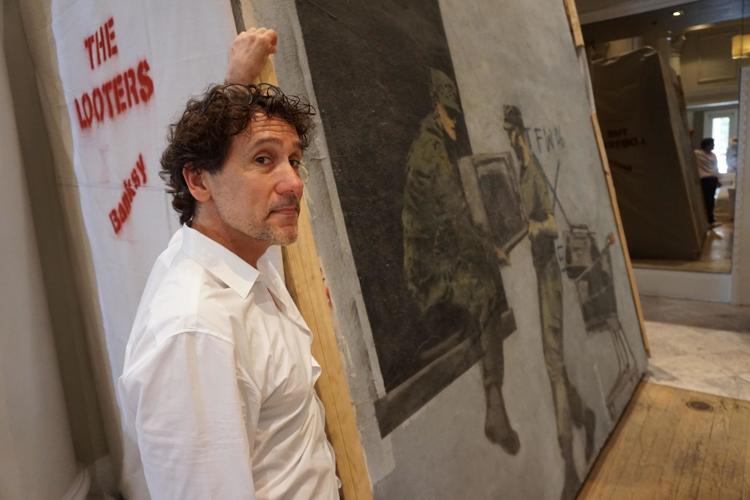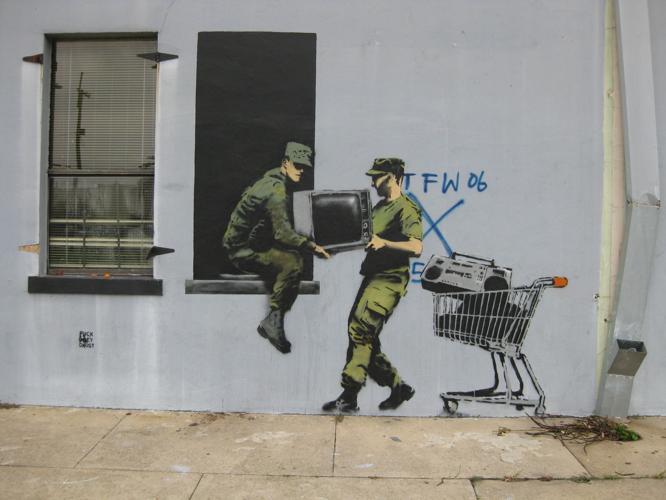It wasn’t easy, but New Orleans hotel owner and real estate developer Sean Cummings has managed to move an 1,600-pound graffiti mural by the British street artist Banksy into the lobby of the International House Hotel at 221 Camp St. where the public can regularly view the post-Katrina icon for the first time since August 2008. It’s a must-see for locals and tourists alike.
Banksy is, after all, the world’s most famous 21st-century artist and the gritty painting is as important to the New Orleans zeitgeist as NOMA’s portrait of Marie Antoinette ever was. More so even.
Here’s the backstory:
While New Orleans was distracted by the approach of Hurricane Gustav in August 2008, the secretive graffiti superstar stole into town. He and assistants produced a suite of 15 stencil paintings more-or-less, many of which were poetic commentaries on the aftermath of Hurricane Katrina and the flood that had devastated the city three years before.
NOLA.COM See 11 of Banksy's New Orleans paintings from 2008
In at least one case, Banksy had permission. Cummings said that before the stencils popped up he had received a mysterious phone call from an acquaintance claiming to represent Banksy. Banksy’s agent asked for permission to produce a mural on an nondescript Elysian Fields building that Cummings owned. Cummings was incredulous, but he agreed.
Note: Everything I’ve written about the Banksy mural so far is supposition. Some believe he orchestrated the graffiti bombing the Crescent City personally; others believe he designed the stencils, but may not have been around for the actual painting. Nonetheless, the paintings that appeared in August 2008 are considered authentic Banksys.
The painting that appeared on Elysian Fields Avenue was immediately controversial because it depicted looters in military uniforms filling a shopping cart with stolen items. The image seemed to imply that the National Guard, which had been deployed to prevent looting during hurricanes Katrina and Gustav, couldn’t be trusted. Banksy’s intended meaning is unknown, but it was safe to say the message was meant to be subversive. More subversive than any of the other compositions by far.
Cummings said his reaction was mixed. “I said, ‘Wow, it’s a signature Banksy irreverently poking the eye of society,’” he recalled. “But, oh boy, the National Guard is going to hate this.”
Graffiti fans celebrated the appearance of the Banksy stencils that were scattered across the city. But not everyone welcomed the English intruder. Soon some of the Banksys were vandalized by jealous graffiti taggers, erased by anti-graffiti activists or overpainted by property owners. Cummings attempted to protect “The Looters,” as the vulnerable painting came to be known, with sheets of plywood and a coat of protective Teflon-like clear varnish. But it was eventually obliterated.
"In the end it was painted over, stenciled over, placards were put over it, even an election poster for Obama was put over it. More than nine layers were covering it," Cummings said in a 2017 interview.
The blotted painting quietly blended into the streetscape until 2014 when Cummings and partners set out to sell the old warehouse. But not before removing the 10-by-10 section of wall that bore the possibly salvageable Banksy. The slab of masonry was delivered to the New Orleans Conservation Guild in the nearby Bywater neighborhood for possible restoration, where it was almost lost for good in a fire.
The rescued artwork was eventually returned to its former glory by conservation professionals who used everything from precision sandblasting to the razor-sharp tips of scalpels to remove the layers of vandalism. Cummings said the cost of the project exceeded $50,000. He ceremoniously unveiled the renewed painting during a one-night exhibit in 2017.
In May 2019 Cummings arranged for the massive artwork to be transported to New Orleans’ Central Business District and shoe-horned through the doorway into the hotel lobby using a special imported device made to move slabs of Italian marble.
“The authenticity of the piece is important,” Cummings said of the restoration. The gray background, he explained, had been retouched to achieve its original appearance, but “never did we put paint on the stencil itself." Cummings said that he considered the result to be “an architectural artifact, in contrast to some sort of pristine, arguably faux restoration.”
In the elegant International House Hotel, Cummings and art director Britney Penouilh have appointed a small room near the painting with photos of the artwork’s history, as well as quotes by Banksy and other information meant to put the painting in context. He predicts that visitors will pose for photos as if they were pushing the looters’ shopping cart. Placing the piece on public view, is the “essential character of street art,” Cummings said. It’s the authentic, right thing to do."
That’s the end of the story … unless you’re interested in reading about one of my worst misjudgments as a newsman, in which case, read on.
Not long after Cummings removed “The Looters” from his warehouse wall, I read a social media post that sounded the alarm that someone was attempting to steal another Banksy (“Umbrella Girl”) from its spot on a dilapidated N Rampart Street building, by sawing it from the wall. Naturally, I assumed the removal was being conducted by the building owner, as Cummings had done.
It was broad daylight, after all, in a busy part of town. The removal seemed too bold and blasé for a crime. So I postponed driving to the site until later in the afternoon. As it turned out, two men had indeed attempted to steal the artwork, until the attention of neighbors finally scared them away. If I’d moved immediately, I would have had a good chance of videoing the attempted theft and been subsequently bathed in YouTube glory.
Suspect in Banksy artwork attempted theft identified by New Orleans police
Correction: The weight of the painting was incorrect in the first version of this story.
Doug MacCash has the best job in the world, covering art, music and culture in New Orleans. Contact him via email at dmaccash@nola.com or dmaccash1@gmail.com. Follow him on Instagram at dougmaccash, on Twitter at Doug MacCash and on Facebook at Douglas James MacCash. As always, please add your point of view to the comment stream.







